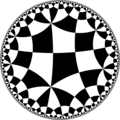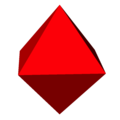Top Qs
Timeline
Chat
Perspective
Order-4 octagonal tiling
Regular tiling of the hyperbolic plane From Wikipedia, the free encyclopedia
Remove ads
In geometry, the order-4 octagonal tiling is a regular tiling of the hyperbolic plane. It has Schläfli symbol of {8,4}. Its checkerboard coloring can be called a octaoctagonal tiling, and Schläfli symbol of r{8,8}.
| Order-4 octagonal tiling | |
|---|---|
 Poincaré disk model of the hyperbolic plane | |
| Type | Hyperbolic regular tiling |
| Vertex configuration | 84 |
| Schläfli symbol | {8,4} r{8,8} |
| Wythoff symbol | 4 | 8 2 |
| Coxeter diagram | |
| Symmetry group | [8,4], (*842) [8,8], (*882) |
| Dual | Order-8 square tiling |
| Properties | Vertex-transitive, edge-transitive, face-transitive |
Remove ads
Uniform constructions
There are four uniform constructions of this tiling, three of them as constructed by mirror removal from the [8,8] kaleidoscope. Removing the mirror between the order 2 and 4 points, [8,8,1+], gives [(8,8,4)], (*884) symmetry. Removing two mirrors as [8,4*], leaves remaining mirrors *4444 symmetry.
Remove ads
Symmetry
This tiling represents a hyperbolic kaleidoscope of 8 mirrors meeting as edges of a regular hexagon. This symmetry by orbifold notation is called (*22222222) or (*28) with 8 order-2 mirror intersections. In Coxeter notation can be represented as [8*,4], removing two of three mirrors (passing through the octagon center) in the [8,4] symmetry. Adding a bisecting mirror through 2 vertices of an octagonal fundamental domain defines a trapezohedral *4422 symmetry. Adding 4 bisecting mirrors through the vertices defines *444 symmetry. Adding 4 bisecting mirrors through the edge defines *4222 symmetry. Adding all 8 bisectors leads to full *842 symmetry.
 *444 |
 *4222 |
 *832 |
The kaleidoscopic domains can be seen as bicolored octagonal tiling, representing mirror images of the fundamental domain. This coloring represents the uniform tiling r{8,8}, a quasiregular tiling and it can be called a octaoctagonal tiling.
 |
 |
Remove ads
Related polyhedra and tiling
Summarize
Perspective
This tiling is topologically related as a part of sequence of regular tilings with octagonal faces, starting with the octagonal tiling, with Schläfli symbol {8,n}, and Coxeter diagram ![]()
![]()
![]()
![]()
![]() , progressing to infinity.
, progressing to infinity.
This tiling is also topologically related as a part of sequence of regular polyhedra and tilings with four faces per vertex, starting with the octahedron, with Schläfli symbol {n,4}, and Coxeter diagram ![]()
![]()
![]()
![]()
![]() , with n progressing to infinity.
, with n progressing to infinity.
 {3,4} |
 {4,4} |
 {5,4} |
 {6,4} |
 {7,4} |
 {8,4} |
... |  {∞,4} |
Remove ads
See also
Wikimedia Commons has media related to Order-4 octagonal tiling.
References
- John H. Conway, Heidi Burgiel, Chaim Goodman-Strauss, The Symmetries of Things 2008, ISBN 978-1-56881-220-5 (Chapter 19, The Hyperbolic Archimedean Tessellations)
- "Chapter 10: Regular honeycombs in hyperbolic space". The Beauty of Geometry: Twelve Essays. Dover Publications. 1999. ISBN 0-486-40919-8. LCCN 99035678.
External links
Wikiwand - on
Seamless Wikipedia browsing. On steroids.
Remove ads































































